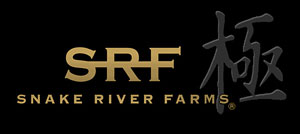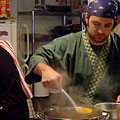Holy Cow
 |
|
I'd like to officially take back any disparaging remarks I may or may not have made about Wagyu-Angus crossbreeds. While I strenuously object to Snake River Farm's debasing of the term "Kobe beef" (if it isn't from the Kobe prefecture, it isn't Kobe, Wagyu or no), I can't deny the fact that their product is absolutely incredible. As previously mentioned, I wanted to use some Wagyu beef for Iron Chef Garlic, but the minimum order at my local purveyor was a full pound whlie I only needed a half. So I decided to give myself a treat for what I assumed, in advance, would be an Iron Chef well-fought. As such, when my one pound NY strip arrived, I had the butcher deli-slice half of it into the carpaccio-thin pieces I needed for my Iron Chef dish, and I retained the rest as an 8-10 oz. half-inch thick steak for my Sunday dinner. This turned out to be a wise move, as I'm fairly certain that this piece of meat will easily coast into my top ten dishes of 2006.
But first, a little lesson in Wagyu.
Wagyu is the breed of cattle that is used to create the justifiably world-famous Kobe beef.* Kobe beef is the legendary beef you've heard of; the product of cows that are regularly massaged and fed the highest quality grains and beer (yes, beer) to create a tender, rich, impossibly marbled steak that frequently commands prices in excess of $100/pound. While we, in the United States, are blessed with exceptionally good beef that is envied the world over (including Japan!), Kobe beef is a luxury food item that is so much in its own class that the US grading criteria don't even apply. Jake probably said it best when he labeled it "Magic Beef +3", and as proud as I was of my dish, he didn't even have it at its best. I regularly have Kobe shabu shabu when traveling in Japan, and I absolutely adore it, but rapidly boiling the beef in broth just doesn't unlock its full potential. It needs to be thinly sliced and quickly seared. If it cooks for too long, the precious fat cooks out, but you want a good sear to caramelize some of the fat and provide the incredibly rich flavor and texture that is almost crispy. It creates a beef flavor that is both full and rich, fatty and moist and succulent and sweet and amazing.
In any case, Kobe beef is like Champagne. There are many sparkling wines, and many the world over are quite exceptional, but if it isn't from Champagne, it isn't Champagne. Similarly, while Wagyu cattle bred and slaughtered outside of the Kobe prefecture may, in fact, be exceptional beef that is completely worthy, it isn't Kobe. Sadly, the on again / off again Japanese-American beef war is on again these days, so we're limited to a domestic supply at the moment. So if you see Kobe beef on a menu in the United States, it means one of two things:
1) The restaurant is smuggling Kobe into the country.
2) What you're actually eating is Wagyu or some crossbreed thereof, which may be tasty, but which almost assuredly isn't as good as the real item.
Nearly everything falls into the latter category. Unfortunately, without the strict quality enforcement that is used in Kobe, American Wagyu covers a wide, wide spectrum. Over the last year, Kobe has become such a culinary buzzword that any mangy American cow with the tiniest hint of Japanese ancestry, no matter how distant, will undoubtedly be sold as Kobe. I had read that many American ranchers were cross-breeding Wagyu with American Angus, in an effort to up production. As such, despite its impressive reputation, I approached my Snake River Farms bounty with mild suspicion.
My suspicion, it turns out, was entirely unwarranted.
I decided to keep things simple. I wanted to taste the beef. So I took my half a NY strip, seasoned it with coarse salt and freshly-ground pepper, and seared it for about two minutes per side in a hot cast-iron pan. Since it had been in my fridge for a couple of days, the result wasn't the prettiest steak I've ever had, but it's quite possible that it was the tastiest. Of course, I am a condiment fiend, so I wanted to put together a little dip of some kind, but I endeavored to keep it light. I'd recently read Jeffrey Steingarten's article on the subject, and he referenced a sauce composed of soy sauce, honey, garlic and miso. All four were in my larder at the time, so I quickly tossed them together and tore into my beef.
I cannot describe how heavenly it was. I mean, it was truly incredible. And not only did it seem that the Wagyu-Angus fusion (dubbed "Wangus" by Jake) wasn't harmful, but rather it gave a new dimension to Wagyu that I'd never tasted before. The steak had the incredible moist, fatty, creamy richness that I've come to expect from Kobe, but there was also an assertive beefy tail that smacked of the American beef I was raised on. It isn't quite the ultra-decadent experience I've had in Japan, but the fact remains that this is a healthy, stable marriage that I hope will remain strong for years to come. At $60/pound, it's clearly special occasion food, but I've paid much, much more for meals that I've enjoyed much, much less. At Snake River Farms, they absolutely know what they're doing, and I look forward to my next good excuse so that I can once again place a special order with my butcher.
* - A correction many years after the fact: The breed isn't Wagyu. That's a very generic term that covers a number of breeds of Japanese cattle. The breed is Tajima-ushi. And I repeat the notion that this Snake River Farms steak was fabulous (even if some subsequent ones I've tried have been considerably less so.) But this doesn't even remotely resemble premium Japanese beef.


Comments